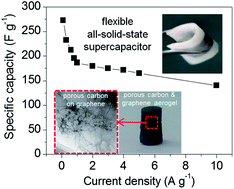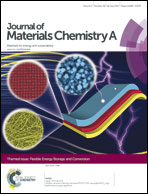Rational design of graphene/porous carbon aerogels for high-performance flexible all-solid-state supercapacitors†
Abstract
Lightweight flexible energy storage devices have aroused great attention due to the remarkably increasing demand for ultrathin and portable electronic devices. As typical new two-dimensional carbon materials, graphene-based porous structures with ultra-light weight and exclusive electrochemical properties have demonstrated outstanding capacitive ability in supercapacitors. Thus far, the performance of all-solid-state supercapacitors achieved from graphene-based materials is still unsatisfactory. In this work, we have rationally designed graphene/porous carbon (GN/PC) aerogels via a simple green strategy to achieve flexible porous electrode materials. The ordered porous carbon (PC) with high specific surface area and good capacitance was introduced as a spacer to efficiently inhibit the restacking of graphene (GN) sheets, which significantly enhanced the specific surface area and facilitated the transport and diffusion of ions and electrons in the as-synthesized porous hybrid structure. The all-solid-state electrodes fabricated by the as-prepared GN/PC aerogels presented excellent flexibility, high specific capacitance and good rate performance in a polyvinyl alcohol/KOH gel electrolyte. Implication of the specific capacitances of ∼187 F g−1 at 1 A g−1 and 140 F g−1 at 10 A g−1 suggests that the GN/PC aerogels promise great potentials in the development of lightweight high-performance flexible energy storage devices.

- This article is part of the themed collection: Flexible energy storage and conversion

 Please wait while we load your content...
Please wait while we load your content...